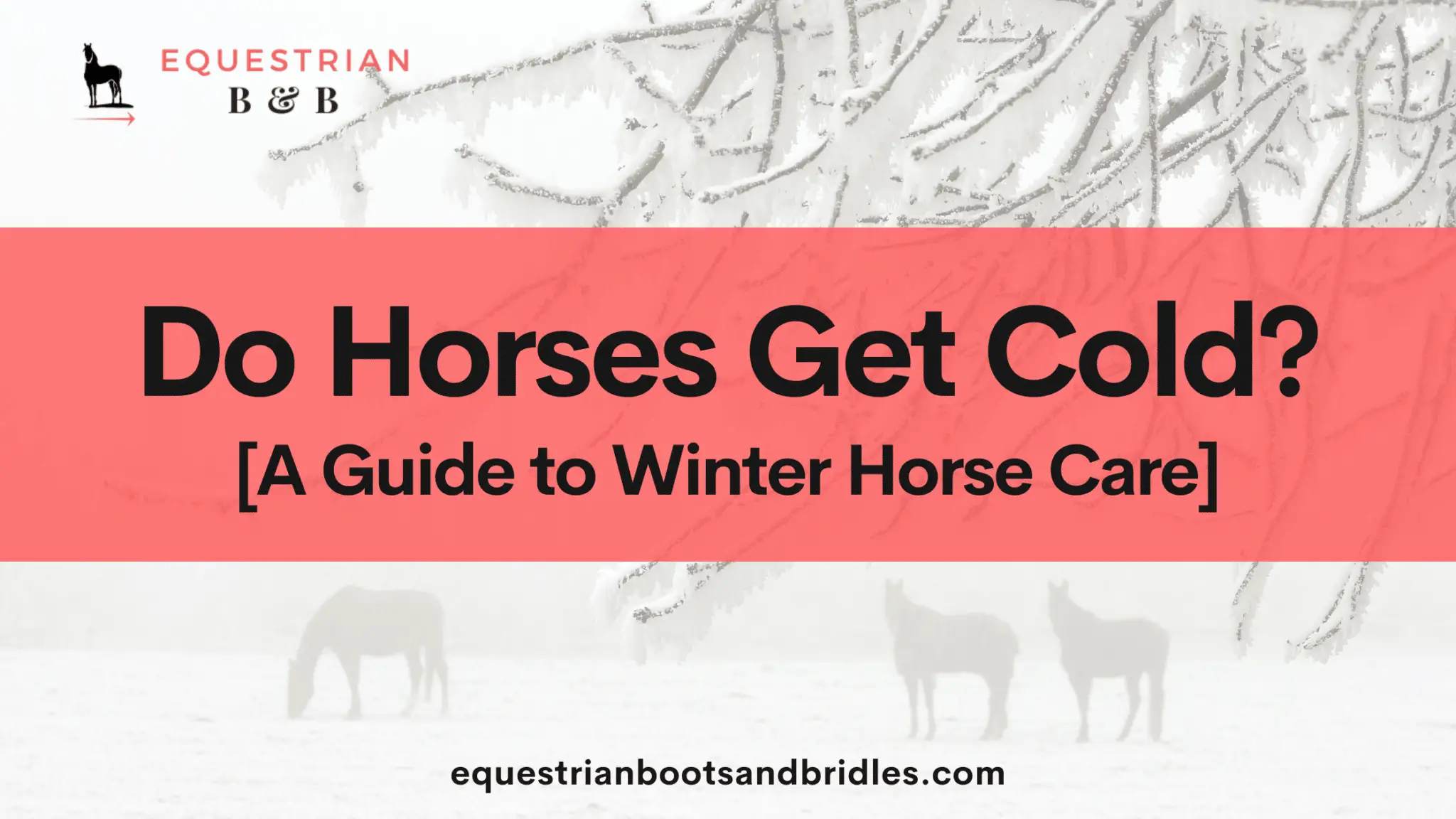You’ve probably seen pictures of horses grazing in a pasture full of snow and wearing a blanket of snow on their uncovered backs. In turn, your instinctive reaction is most likely to be one of “Brrrr! They have to be freezing!”
But do horses get cold like people do?
As a general rule, no. Horses are designed to handle cold weather and related conditions, but the ultimate answer is that it depends on the individual horse.
The physiology of a horse helps them handle the cold in such a way that it doesn’t bother them. There’s always a barn prince or princess who won’t go outside without a sheet when the temperatures dip, but they’re the exception to the rule. A horse that’s in good physical condition and has an adequate fat layer can readily handle cold weather, provided they’re of a mind to do so.
It’s a good idea to engage in hair coat management if you use your horse for performance or training on a year-round basis. The very effectiveness of a horse’s coat and physiology causes it to sweat harder in the winter after exertion. Clipping and blanketing helps your horse shed heat and sweat less during the winter.
Read on to learn more about why horses don’t get cold in the winter and what you can do to help them stay comfortable.

How the Winter Coat Grows
Horses have an internal sensor that tells them it’s time to grow a winter coat when the days start getting shorter.
You might not notice it right away, but the coat changes slowly. Their short, summer coat stays in place year-round, but longer hair starts growing in on top of the short ones. These hairs, sometimes known as guard hairs, stand up on top of the summer coat and give the horse a fuzzy appearance. This creates a dual-layer coat, one for insulation, and the other for protecting against wind, snow, and wet.
How a Horse’s Head Handles Cold Air
Next time someone asks your horse “why the long face”, you can explain that their face conceals long sinus cavities that heat up air as it passes through to the neck and lungs.
This function is the same in all mammals, but horses evolved to have long, square heads with sinuses that run the length of their head to their neck. Cold air is warmed up by the time it reaches the neck and passes to the trachea. This eliminates the delivery of a cold shock to the lungs (although cold air can still sting when going from a warm environment to a cold one). That’s why horses sometimes “nope” at cold weather and go back in, or go running like their tails are on fire after being turned out.
You can get an idea of how this process works by paying attention to how air feels in your nose when it’s cold out. Take a deep breath through your nose and pay attention to the sensation as it transitions from your nose to your throat, and as it hits your lungs. This is similar to how a horse experiences breathing in cold air. Humans have shorter noses, but then again, we can cover it up to warm the air. Horses can’t, and as a result, their bodies have evolved to handle cold air.
Why Horses Have Long Necks
The length of a horse’s neck is another evolutionary trait as it enables the horse to adjust its vision, graze, and further warm cold air before it reaches the lungs. The air that’s transferred from the nose to the neck is already warmed up, but the distance from the neck to the lungs brings the air to a higher temperature and makes it easy to breathe in without shock.
The mane also plays a role in insulating the neck, making it a good idea to let it grow out during the winter.
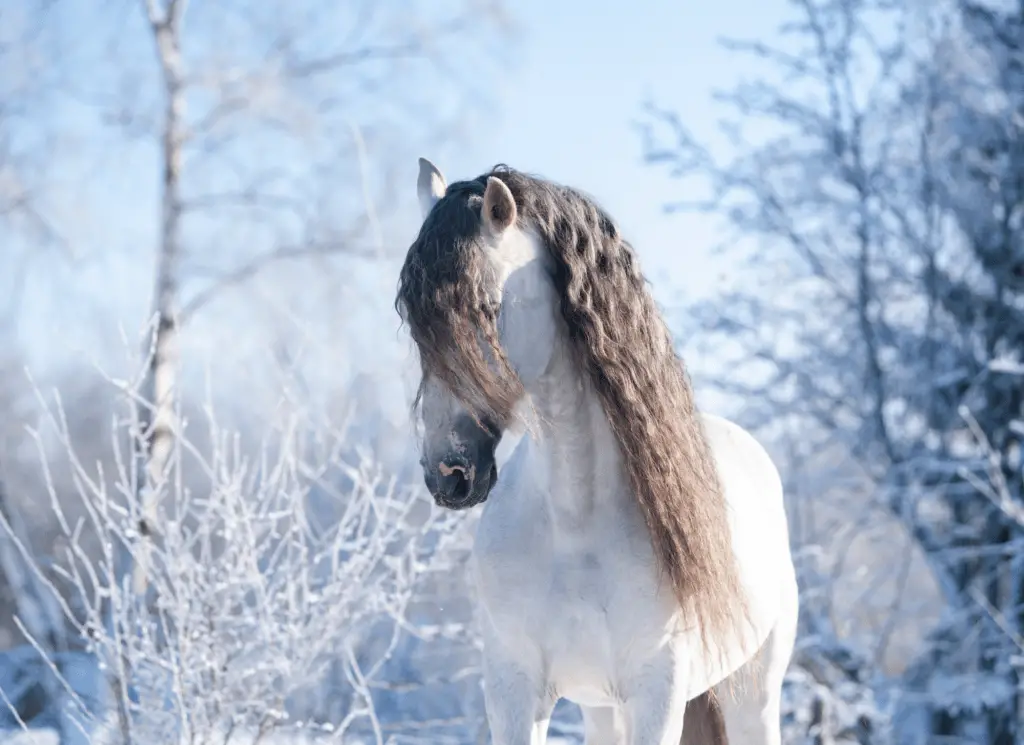
How the Digestive System Helps
Horses ferment their meals in their hindgut, which helps it stay warm. The heat is circulated through the body and helps maintain a constant body temperature. Horses that spend time outside should have plenty of access to forage to help them generate heat and let this natural heat source do its best work.
Hooves and Legs Don’t Transmit Cold
The horse’s leg is made up of tendon and bone, but has robust circulation to the hoof and coffin bone. You’d think the cold from the ground would transmit to the blood flow and bring it back to the horse’s body, except for the fact the horse intermittently shunts the blood flow away from its hooves.
This is thought to minimize the transmission of cold to the body as the horse’s body stops the blood flow to the leg at intervals.
This mechanism also increases the risk of laminitis, although a healthy horse with no underlying conditions won’t experience a bout of cold-induced laminitis. However, a horse that’s already compromised is at higher risk of an episode because it can’t tell its body to keep the blood flow going regardless.
You’ll want to be proactive in managing the turnout in the cold for a horse with a chronic health condition.
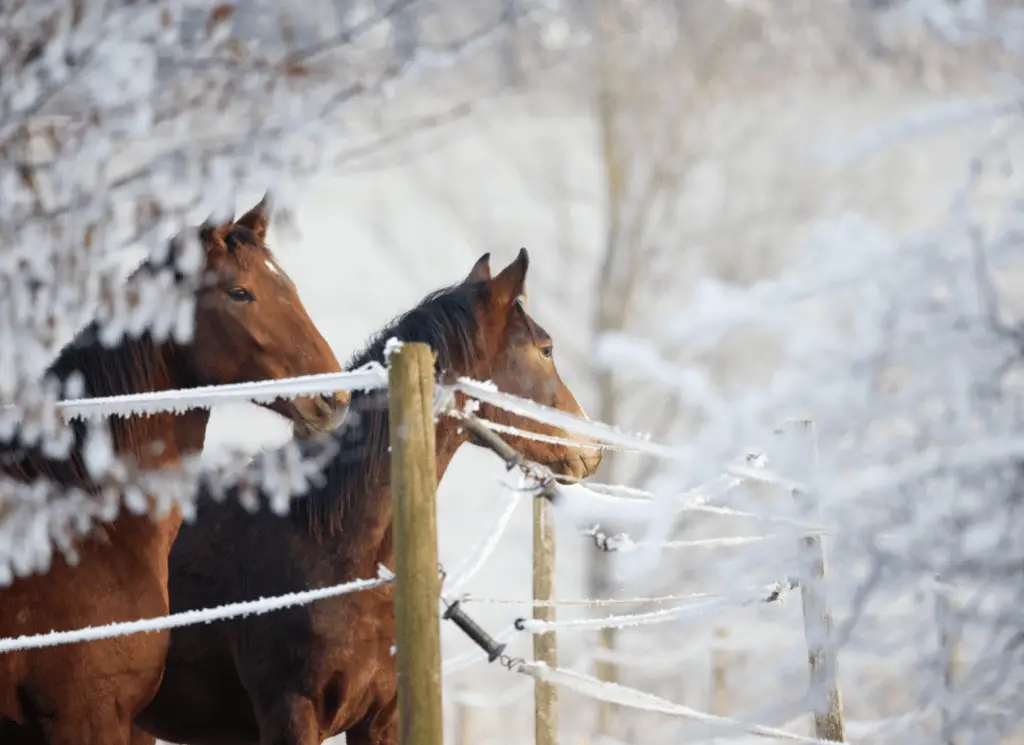
Fat As An Insulator
A horse that lives in the wild or lives the life of a pasture puff spends the months prior to winter looking for extra forage. Their body signals it to eat more to increase the amount of body fat they carry. The extra fat covers the rib cage and lungs to help hold in body heat.
You can increase your horse’s forage amounts as the weather cools down to help it gain some weight, but you don’t want them to become obese, either. An extra flake of hay at feeding times supplies sufficient calories, or you can pour a cup of corn oil into the hard feed.
A horse that has an adequate amount of body fat and a thick hair coat is one that can handle snowy conditions. In fact, these insulating layers are so effective that they can carry around a blanket of snow on their backs and not have it melt. The snow also acts as an additional layer of insulation, strange as that sounds, and helps the horse stay comfortable.
How Their Coat Helps With Insulation
A horse’s coat is their best protection against cold. The coat contains oils that act as waterproofing, and the hairs stand up which traps pockets of air. The waterproofing of the oils prevents melting snow from getting to the skin, and the pockets of air hold warmth. This is another aspect that causes snow to blanket a horse’s back without melting.

Should Horses Be Blanketed?
Most horses manage to grow a coat that protects them from the cold, but there are always exceptions to the rule.
To begin with, horses have a light receptor that tells it when it’s time to grow and time to shed their coats. This receptor is stimulated by the winter and summer equinoxes. When the receptor senses the days are growing shorter, it sends out a signal to the body to start growing the winter coat.
The same is true when the days get longer. Allowing a horse to follow its natural coat growing rhythms usually results in a coat that’s adequate for the winter.
However, all horses are individuals and some grow heavier coats than others. The density of a horse’s hair coat is attributable to age, chronic illness, genetics, and breed. Then there are some horses that grow a lousy winter coat no matter what you try. Horses with a poor winter hair coat will benefit from being blanketed, and it won’t affect the density of their coat as they won’t grow the adequate hair layers to keep them warm.
Show horses that are kept in training during the winter months should also be blanketed. They’re prone to sweating from exertion, and take longer to cool off when the workout is finished. This puts them in an uncomfortable state afterwards, and it’s a rare barn that’s equipped for hot water baths in the winter.
Walking a horse to cool it off is another option, but again, this takes time and may not be convenient. Blanketing a show horse when the nights are cool helps to slow down hair growth and enables a horse to cool down more quickly after a workout. It should be noted that a horse whose coat is managed in this fashion also needs to wear a blanket when stabled or pastured.
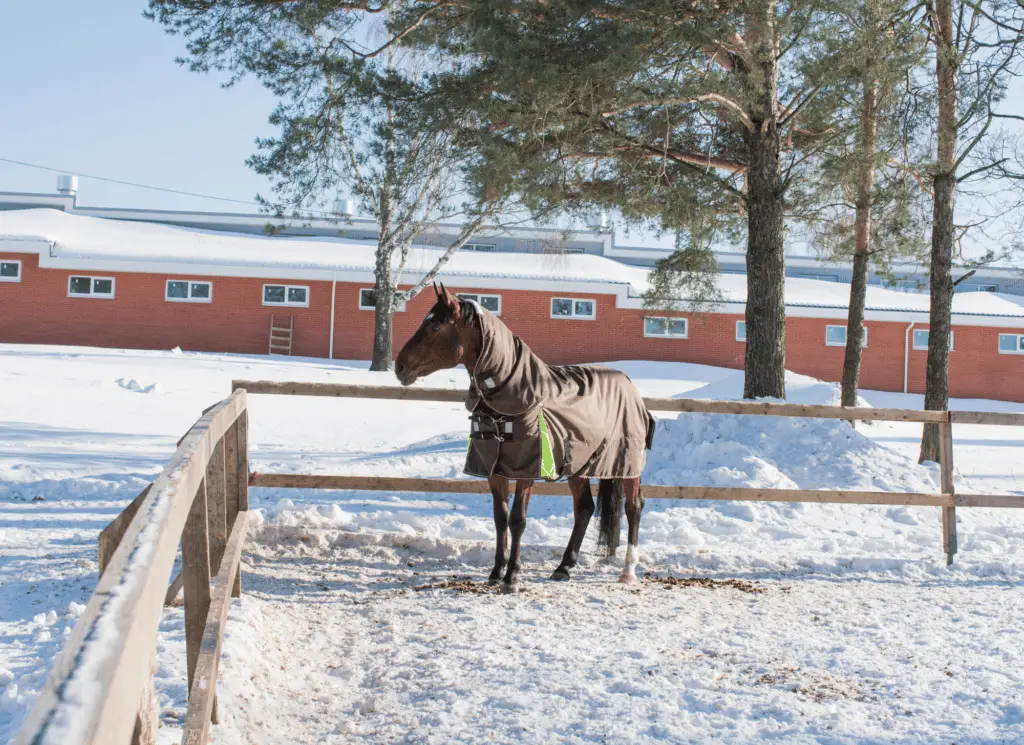
Preparing Your Horse for Winter
Most of the time, a horse prepares itself for winter without much help from you. But if you intend to keep a training schedule, ride, or drive your horse during the winter, you’ll want to take steps to manage your horse’s hair growth.
Putting a sheet on your horse when the nights are cool will help minimize winter hair growth, although it won’t stop it from growing entirely. The winter hair coat grows shorter, making it more manageable for exercise and cooling down. You’ll need to blanket your horse for turnout if you decide to go this route for coat management. (This article will help you pick out a blanket.)
Some individuals are prone to growing a thick coat no matter what you do. This is when you prepare to give your horse a blanket clip to help it shed heat and not sweat so heavily.
A blanket clip is a front to rear clip of your horse’s coat from the top of the legs to about mid chest. You clip parallel to the ground and take the hair down to a short length. If your horse will tolerate getting their belly clipped, go ahead and remove some of the hair, and be sure to leave a patch intact in the girth area.
Signs That Your Horse is Cold
A horse that has adequate insulation from its hair and fat layers doesn’t react to the cold. They may look like they’re cold to the eye, but if a horse is acting normally and not showing signs of stress, they’re fine.
Horses are more self-sufficient than people give them credit for, and they will seek shelter if they are cold. However, it’s possible for a horse to get cold if it’s compromised in some way.
Signs of a cold horse include:
- Shivering
- Stomping feet
- Agitation
- Tucked tail
- Huddling with other horses
- Cold ears
- Low body temperature under 100
- Consuming more feed without weight gain
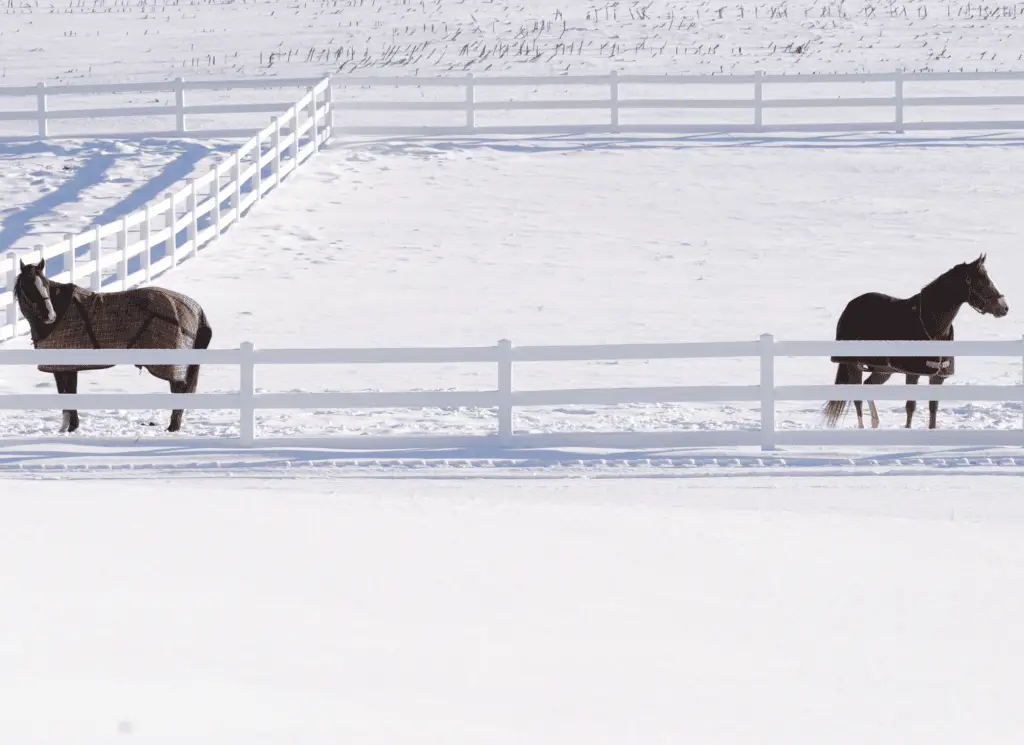
What to Do If Your Horse is Cold
The first thing you should do is take your horse into the barn and put it in a stall, then put on a blanket to help the horse warm up. Make sure it has adequate forage to consume and help it raise its internal body temperature.
Take its temperature to determine how cold it is, and call the vet for further guidance.
Your horse may have a low-grade virus or a chronic condition that’s affecting their ability to self-regulate their body temperature. A veterinarian can assess your horse and perform tests that help determine the reason or cause of your horse’s loss of body temperature.
The phrase of “if you’re cold, they’re cold” doesn’t apply to horses. You may see your horse shiver a little bit in cold weather, but if the action lasts for a few seconds and doesn’t happen repeatedly, your horse is fine.
Make sure to provide your horse with plenty of forage, a place where it can shelter from the wind when it’s outside, and fresh water to help it stay comfortable during turnout. It helps it stay healthy, comfortable, and in touch with their natural body rhythms.
Like this post? Save it on Pinterest. Follow me on Pinterest.


